My friend Richard had a big problem. His most treasured possession, his guideboat, leaked. And not just a small leak, but it leaked big time, like the proverbial sieve. It was very special to him because his boo bah (grandfather) Fred Burns built it. You have heard of Fred, a renowned Long Lake guideboat builder, in an earlier blog. I told Richard to bring it over and I would have a look at it. The first I knew it was parked on our screen porch in Long Lake. Here I pose with Richard (I am the tiny one).

I learned from Richard that the boat had been overwintered in a hot, dry spot. This is the curse of wooden boats, especially guideboats. The seams dry out, but worse yet, they become irreversibly dry. No manner of submerging the the boat in water can restore the hull to original water-tight state. You see, wood and water play an delicate dance. A growing tree consists of mostly water, perhaps 80-90%. Because of that its branches are quite supple and can easily bend to ward off heavy winds. To make wood useful, the lumber man drives off the excess moisture. This brings the moisture content down to around 15%. However if we drive off too much water from wood it loses its resiliency and becomes brittle.
Then comes the boat builder who would like to return the wood to it original high moisture content so he can bend it to the shape he desires (Musical instrument makers have the same desire). They employ steaming to drive the moisture back into the wood. Steaming raises not only the moisture content of wood but its temperature as well. As these two factors reach a critical point wood becomes quite pliable and can be bent into very elaborate shapes. These shapes remain permanent upon cooling.
As wood pick up moisture it expands and as it loses moisture it shrinks. As long as its moisture content is not allowed to fall too far this contraction/expansion cycle can continue indefinitely. But when the moisture content of wood is allowed to drop too low, soaking at room temperature does not allow enough water to enter the descicated wood to produce any appreciable swelling. So Richard’s guideboat had reached this state of no return where no amount of soaking resulted in enough water uptake by the hull to stop the leaks.
What to do? After some thought it came to me to use the same bedding compound I use in building my guideboats. It is called Sikaflex 291 LOT, The LOT stands for long opening time. Thus it takes 291 several hours to cure. That means it can be “pushed and shoved” into gaps to fill them without any time constraint on the “pusher and shover”. It comes in a tube that fits a caulking gun.
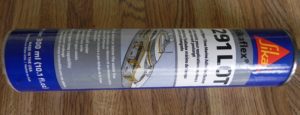
Not having seen where the leaks were occurring I decided to attack the garboard plank and the bottom board first. I had noticed that there were some visible openings there as well. So I did my best to plug that area and gave Richard a call.
He brought his daughter and the two of them hauled the boat down to my dock for a water test.
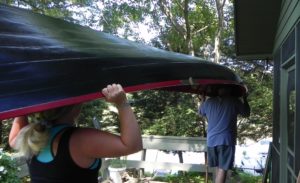
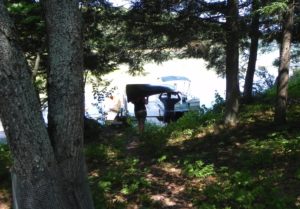
No dice! The boat still leaked mightily. So we agree to take the gloves off and go after every seam. This shows the job partly done with the 291 in some of the inboard seams.
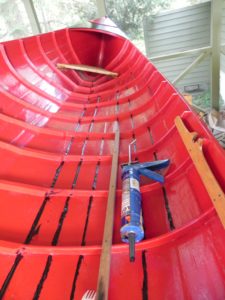
I grew tired of sealing the seams so Richard took over. He takes his boat to his shop at the Long Lake Camp for the Arts. He improves upon my caulking technique by using a high powered LED flashlight to shine along the hull. He applies the 291 wherever light shines through the seams.
Finally the day arrives when another water test is called for. The boat is shoved in the back of his pick up and off we go down to the lake shore.
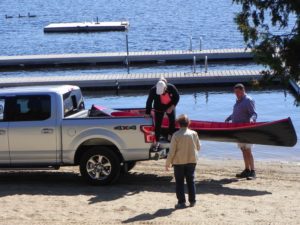
It happens to be a beautiful day in the Adirondacks.
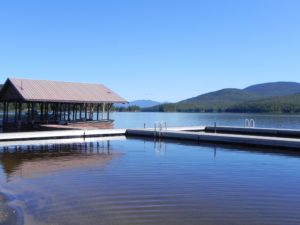
Richard is a bit cautious as he is reluctant to throw his whole self into the boat before he is sure it leaks no more.
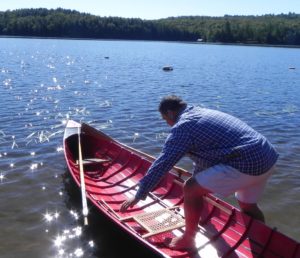
It looks good but still not ready to jump in. Let’s check one move time.
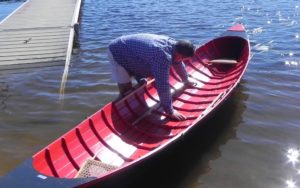
It still looks like a go. So off he goes.
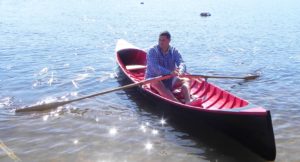
The boats is sound and back to being Richard’s pride and joy.
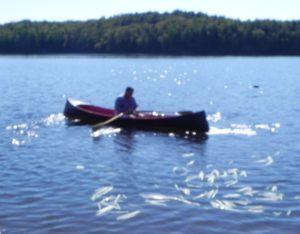
This is a day that Richard thought would never come true.